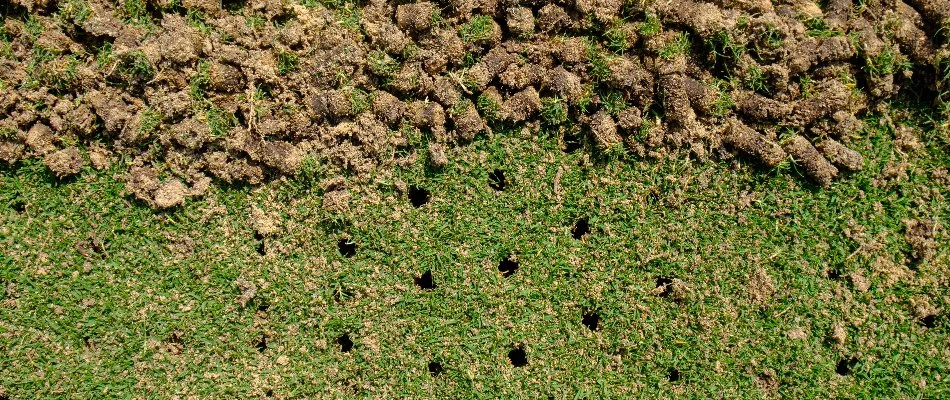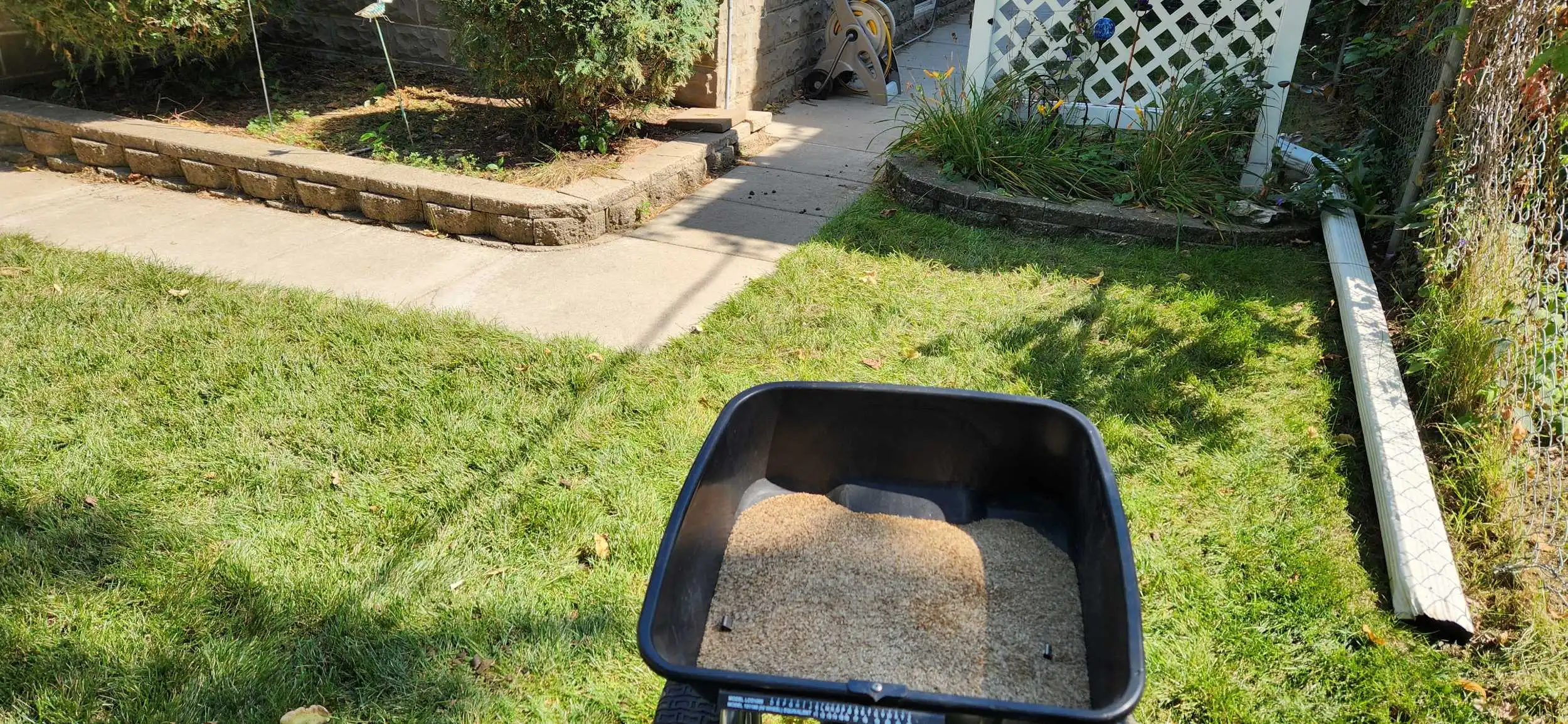Fall lawn aeration benefits aren't just nice-to-have—they're the backbone of a resilient, good-looking cool-season lawn in Sioux Falls, SD and the Sioux City metro. This guide explains why late-summer through early fall is the prime window, how aeration actually helps your turf (and soil), and exactly how to pair it with overseeding for thicker, greener results. You'll receive practical, Midwest-specific tips that you can act on right away, along with a clear plan for aftercare, so your lawn finishes the season strong and wakes up ready in spring.
What is lawn aeration (and why your soil needs it)
Aeration is the process of creating small openings in the lawn so water, air, and nutrients can reach the root zone. In the Midwest, foot traffic, mowing, and heavy clay-leaning soils cause compaction over time. Compacted soil squeezes out pore space, slowing root growth and making turf more vulnerable to drought, heat, and disease stress.
There are two common approaches:
- Core (mechanical) aeration: A machine removes thumb-sized cores at regular spacing, physically relieving compaction and improving infiltration and root expansion.
- Liquid aeration: A soil-conditioning application that helps loosen tight soils and improve structure over time, useful where machines can’t reach.
Both have a role, but for fast, visible relief of compaction and immediate seed-to-soil contact, core aeration shines in late summer and early fall.

Why late-summer to fall is the sweet spot in the Sioux City & Sioux Falls area
Cool-season grasses (Kentucky bluegrass, turf-type tall fescue, and perennial rye) put serious energy into roots as temperatures ease. In our region, that shift starts late August and runs through October, depending on the year. Aerating in this window multiplies your return because:
- Soil is warm, air is cooler: Roots grow aggressively as temperatures ease, and aeration channels amplify that root push.
- Lower weed pressure vs. spring: Growth improves without peak summer annual competition (pause pre-emergents if seeding).
- More cooperative moisture: Gentler fall rains and lower evaporation make watering more efficient.
- Winter readiness: Deeper rooting stores carbohydrates for better winter survival and faster spring green-up.
Midwest timing tip: In Sioux Falls, SD and Sioux City, aim core aeration for late August through late September. Overseeding pairs best when soil temps are roughly 50–65°F at the 2" depth. This window closes fast—don't push it into late October unless the season is unusually warm.
Fall lawn aeration benefits (the short list with significant impact)
Here's what aeration delivers when timed for late summer and fall:
- Real compaction relief: Core removal breaks dense soil so roots can access oxygen.
- Better water use: Channels reduce runoff and puddling, pushing water into the root zone.
- Improved nutrient efficiency: Fertilizer reaches active roots instead of sitting on the surface.
- Healthier microbiology: Oxygen exchange supports beneficial soil life.
- Thicker turf over time: Reduced compaction and better nutrition encourage dense tillering that suppresses weeds.
- Perfect prep for overseeding: Holes create micro-sites for seed-to-soil contact, moisture retention, and even germination.
Aeration + overseeding: the power combo for a thicker lawn
If your lawn looks tired, thin, or patchy after summer, pairing aeration with overseeding is the most reliable one-two punch. Aeration sets the table; overseeding serves the meal. Here's how to make it count:
- Choose the right seed: In our market, high-quality turf-type tall fescue mixes perform beautifully for durability and drought tolerance; Kentucky bluegrass and perennial rye are also common fits. Select improved cultivars suited to the Upper Midwest.
- Time it right: Seed immediately after aeration while cores are fresh and channels are open.
- Ensure seed-to-soil contact: Broadcast seed, then lightly drag or rake to settle seed into the holes and top ¼". Avoid burying deeper than ½".
- Water correctly: Keep the seedbed consistently moist with light, frequent cycles—3–4 brief waterings per day until germination, then taper gradually to deeper, less frequent watering.
- Be patient with germination: Fescues can take 7–14 days, bluegrass often 14–21+ days. You'll see staggered sprouting in cooler weather—totally normal.
- Pause certain weed controls: Avoid pre-emergent herbicides for several weeks before and after seeding; they block grass seed along with weeds.
Pair fall aeration with our overseeding service for maximum thickening, or read about our aeration service to understand the steps and aftercare.
Our proven fall aeration process (what to expect)
We keep it simple and effective—no gimmicks, just the right work at the right time.
- Assessment & timing: We evaluate grass type, density, and recent weed control history to schedule your visit inside the prime window for Sioux Falls, SD and surrounding communities.
- Site prep guidance: We'll ask you to mow a bit shorter (about 2 inches) the day before and bag clippings, mark hazards (sprinkler heads, invisible fences, shallow lines), and water lightly if soils are very dry so cores pull cleanly.
- Core aeration (and liquid, where appropriate): Our team pulls consistent cores across open areas, with extra passes on high-traffic or compacted zones. In tight or inaccessible areas, liquid soil conditioning may be used to complement the work.
- Optional overseeding: If you choose overseeding, we seed immediately after aeration and, if needed, lightly topdress or drag for better contact.
- Aftercare plan: We leave you with precise watering and mowing guidance, plus a straightforward schedule for your next fertilization step.
Sioux City & Sioux Falls specifics: soils, seasons, and practical tips
Local context matters. Here's how to think about aeration and seeding in our market:
- Soils: Clay-leaning soils compact easily; annual core aeration (twice for high-traffic lawns) preserves pore space.
- Seasonal swing: Hot, breezy summers and cold winters—fall aeration deepens roots before freeze-up.
- Seeding window: Late Aug–late Sep is typically best; early Oct only if soils stay warm.
- Watering reality: Use short, frequent cycles for new seed; transition to deeper, less frequent watering after establishment.
- Mowing approach: Mow at ~3–3.5" with sharp blades; resume when seedlings reach height.
Trust the process: If summer drought or heat left the lawn stressed, fall aeration can "wake up" prior nutrition once moisture returns. Expect steady improvement through fall and a strong jump in spring.
Common questions about fall aeration
Do I need to rake up the cores?
No. Let them dry for a few days, then mulch them back in with mowing. They break down into a light topdressing and refill the holes with looser soil.
Can I aerate if I have an irrigation system?
Yes—please flag heads and shallow lines. We're careful around marked utilities and will coach you on what to flag.
Is liquid aeration enough on its own?
Both liquid and core aeration are effective methods; they just work in different ways. Liquid aeration loosens the soil and improves root growth across the entire lawn, while core aeration does so by pulling plugs. Using liquid aeration on its own is a solid, proven choice that delivers great results without the mess.
How soon after aeration can I fertilize?
Right away in most programs. The open channels help nutrients reach roots. If you seed, follow a starter fertilizer plan and avoid certain weed controls until seedlings are established.
What about weeds after aeration?
Thicker turf is your best defense against weeds. If you're seeding, pause pre-emergent applications around the seeding window. Once new grass is mature, your normal program resumes.
Step-by-step aftercare (post-aeration and post-seeding)
- Irrigation: If seeded, keep the top ½" of soil consistently moist with light, frequent cycles (3–4 times daily) until germination. After emergence, gradually reduce frequency and increase depth.
- Mowing: Resume at 3–3.5" when new grass reaches mowing height. Never remove more than 1/3 of the blade at once.
- Traffic: Limit foot and pet traffic on newly seeded areas for the first month. Full durability comes as seedlings mature over several weeks.
- Nutrition: Follow your fall fertilizer schedule; the lawn will use nutrients efficiently through those aeration channels.
- Patience: Expect staggered germination and some pale new tissue at first—that's normal. Color and density fill in with proper watering and mowing.
Learn more about overseeding, or see how our aeration service fits into a complete fall plan. For soil health support, ask about pairing aeration with our soil-conditioning add-on.
DIY vs. professional aeration
You can rent a core aerator, but be realistic about weight, transport, technique, and coverage. Professional crews deliver consistent plug depth and spacing, know when to make multiple passes, and can integrate overseeding, fertilization, and irrigation guidance into one visit. If your lawn is large, uneven, or has many obstacles, professional service usually pays for itself in quality and saved time.
Quick checklist: is your lawn a candidate right now?
- Soil feels hard underfoot or water puddles during rain
- Roots are shallow (you notice drought stress fast)
- High traffic from kids, pets, or equipment
- Thin areas from summer heat or disease
- Haven't aerated in the last 12 months
If you checked two or more, it's time to book.
References & further reading (authoritative sources)
For deeper, university-based guidance on cool-season turf and fall cultural practices, see:
- Iowa State University Extension & Outreach – Horticulture & Turf
- South Dakota State University Extension
- University of Minnesota Turfgrass Science
Conclusion: act in late summer to supercharge fall growth
When you aerate as summer breaks and pair it with overseeding, you unlock the best growing conditions of the year for cool-season turf. Fall lawn aeration benefits include deeper roots, better water use, stronger microbial activity, thicker density, and a head start on next spring. This is the window to fix summer damage, prepare for winter, and set the stage for the greenest possible start next year.
Ready to schedule? We serve homeowners, businesses, and HOAs across Sioux Falls, SD and the Sioux City metro. Book fall aeration (and overseeding, if needed) before the window closes.
Call us today to put your fall plan in motion
At Sharp Lawn Care, our fall program focuses on the right work at the right time—no "cookie-cutter" shortcuts. We'll assess your lawn, schedule inside the prime window, and deliver a clean, confident result you can see. For service in Sioux Falls, SD, call (605) 251-6880. For Sioux City and surrounding areas in Sioux City, IA, call (712) 253-8024. Prefer to click? Learn more about our aeration and overseeding services and request a visit today.




Comments (0)
Thanks for your comment!
Thanks for your feedback! Your comments have been successfully submitted! Please note, all comments require admin approval prior to display.
Error submitting comment!
There is a problem with your comment, please see below and try again.